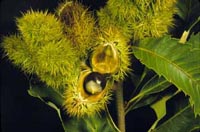Resource Library
Plant of the Week: Ozark Chinquapin
The University of Arkansas System Division of Agriculture does not promote, support or recommend plants featured in "Plant of the Week." Please consult your local Extension office for plants suitable for your region.
Plant of the Week
Ozark Chinquapin
Latin: Castanea pumila var. ozarkensis

As the drumbeat of war increases and with the possibility of biological warfare looming on the horizon, it’s natural to reflect on how new diseases impact a susceptible population.
Plant communities too are susceptible to foreign diseases, and the 20th century is rife with examples of imported plagues blighting our countryside. One of the best studied of these foreign plagues was chestnut blight, which made its debut early in the century.
Chestnut blight was first described in the Bronx Zoo in 1904 but had probably been killing American chestnut trees in scattered pockets across the eastern seaboard for several years prior to that date. Nut bearing Japanese chestnut cultivars, with fruits larger than their native cousin, were widely available in the nursery trade of the day. Parsons Nursery in Flushing, N.Y. was the first to offer grafted trees in 1876, but by the end of the century several other selections had been imported by different nurseries.
By 1912, the epidemic had swept across most of New England and Pennsylvania, leaving 100-foot tall skeletons of American chestnuts in its wake. By 1940, the fungus had spread throughout the range of the American chestnut and jumped to the related species found in Arkansas, the Ozark Chinquapin (Castanea pumila var. ozarkensis) where it continued its destructive ways.
The disease attacks the cambium region of the tree, killing the top completely but allowing trunk suckers to regrow from the base. These suckers often reach the diameter of a fat man’s leg when they are again killed back to the ground. After several cycles of this kind of attack, the tree that used to coexist with oaks and hickories as an equal now is little more than a shrub in the understory of the forest.
The Ozark Chinquapin has 5-inch long, serrate-margined leaves that are dark green above and whitish beneath. The flowers appear in May as creamy white, fishy smelling panicles about the size and shape of your index finger. In the fall, spiny burs about the size of a golf ball appear which contain a brown, edible nut.
The fact that the Chestnut and Chinquapin has not been restored to its place of prominence in the American forest is not for want of trying. Breeding efforts using the functionally resistant Chinese and Japanese species in combination with the susceptible American species have been ongoing for almost a century, but to date, no completely satisfactory replacement has been found.
A new approach, and one that may hold promise for future generations of chestnut fanciers, is the discovery of a virus disease that attacks the fungus disease. Studies are underway to introduce virus-infected disease into the fungus population of orchards to create "hypovirulent" strains of the disease.
The most commonly seen chestnut is the Chinese chestnut (Castanea mollissima), which is completely resistant to the fungus disease. It makes a spreading, 50-foot tall tree with heavy nut crops. Some hybrid trees containing parentage of the American chestnut are also available from specialist propagators. They are best grown as yard trees where they have room to grow.
By: Gerald Klingaman, retired
Extension Horticulturist - Ornamentals
Extension News - March 7, 2003
The University of Arkansas System Division of Agriculture does not maintain lists of retail outlets where these plants can be purchased. Please check your local nursery or other retail outlets to ask about the availability of these plants for your growing area.